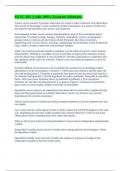Exam (elaborations)
EESC-101 || with 100% Accurate Solutions.
- Course
- Institution
Science correct answers Systematic observation of events in order to discover facts about them. Also a body of knowledge. Can be verified for further investigation. Is a process of discovery that requires reproducibility, peer review, and skepticism Environmental Science correct answers Interdis...
[Show more]



